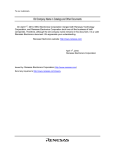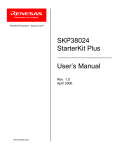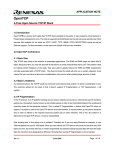Download EDK2239 User Manual - Digi-Key
Transcript
To our customers, Old Company Name in Catalogs and Other Documents On April 1st, 2010, NEC Electronics Corporation merged with Renesas Technology Corporation, and Renesas Electronics Corporation took over all the business of both companies. Therefore, although the old company name remains in this document, it is a valid Renesas Electronics document. We appreciate your understanding. Renesas Electronics website: http://www.renesas.com April 1st, 2010 Renesas Electronics Corporation Issued by: Renesas Electronics Corporation (http://www.renesas.com) Send any inquiries to http://www.renesas.com/inquiry. Notice 1. 2. 3. 4. 5. 6. 7. All information included in this document is current as of the date this document is issued. Such information, however, is subject to change without any prior notice. Before purchasing or using any Renesas Electronics products listed herein, please confirm the latest product information with a Renesas Electronics sales office. Also, please pay regular and careful attention to additional and different information to be disclosed by Renesas Electronics such as that disclosed through our website. Renesas Electronics does not assume any liability for infringement of patents, copyrights, or other intellectual property rights of third parties by or arising from the use of Renesas Electronics products or technical information described in this document. No license, express, implied or otherwise, is granted hereby under any patents, copyrights or other intellectual property rights of Renesas Electronics or others. You should not alter, modify, copy, or otherwise misappropriate any Renesas Electronics product, whether in whole or in part. Descriptions of circuits, software and other related information in this document are provided only to illustrate the operation of semiconductor products and application examples. You are fully responsible for the incorporation of these circuits, software, and information in the design of your equipment. Renesas Electronics assumes no responsibility for any losses incurred by you or third parties arising from the use of these circuits, software, or information. When exporting the products or technology described in this document, you should comply with the applicable export control laws and regulations and follow the procedures required by such laws and regulations. You should not use Renesas Electronics products or the technology described in this document for any purpose relating to military applications or use by the military, including but not limited to the development of weapons of mass destruction. Renesas Electronics products and technology may not be used for or incorporated into any products or systems whose manufacture, use, or sale is prohibited under any applicable domestic or foreign laws or regulations. Renesas Electronics has used reasonable care in preparing the information included in this document, but Renesas Electronics does not warrant that such information is error free. Renesas Electronics assumes no liability whatsoever for any damages incurred by you resulting from errors in or omissions from the information included herein. Renesas Electronics products are classified according to the following three quality grades: “Standard”, “High Quality”, and “Specific”. The recommended applications for each Renesas Electronics product depends on the product’s quality grade, as indicated below. You must check the quality grade of each Renesas Electronics product before using it in a particular application. You may not use any Renesas Electronics product for any application categorized as “Specific” without the prior written consent of Renesas Electronics. Further, you may not use any Renesas Electronics product for any application for which it is not intended without the prior written consent of Renesas Electronics. Renesas Electronics shall not be in any way liable for any damages or losses incurred by you or third parties arising from the use of any Renesas Electronics product for an application categorized as “Specific” or for which the product is not intended where you have failed to obtain the prior written consent of Renesas Electronics. The quality grade of each Renesas Electronics product is “Standard” unless otherwise expressly specified in a Renesas Electronics data sheets or data books, etc. “Standard”: 8. 9. 10. 11. 12. Computers; office equipment; communications equipment; test and measurement equipment; audio and visual equipment; home electronic appliances; machine tools; personal electronic equipment; and industrial robots. “High Quality”: Transportation equipment (automobiles, trains, ships, etc.); traffic control systems; anti-disaster systems; anticrime systems; safety equipment; and medical equipment not specifically designed for life support. “Specific”: Aircraft; aerospace equipment; submersible repeaters; nuclear reactor control systems; medical equipment or systems for life support (e.g. artificial life support devices or systems), surgical implantations, or healthcare intervention (e.g. excision, etc.), and any other applications or purposes that pose a direct threat to human life. You should use the Renesas Electronics products described in this document within the range specified by Renesas Electronics, especially with respect to the maximum rating, operating supply voltage range, movement power voltage range, heat radiation characteristics, installation and other product characteristics. Renesas Electronics shall have no liability for malfunctions or damages arising out of the use of Renesas Electronics products beyond such specified ranges. Although Renesas Electronics endeavors to improve the quality and reliability of its products, semiconductor products have specific characteristics such as the occurrence of failure at a certain rate and malfunctions under certain use conditions. Further, Renesas Electronics products are not subject to radiation resistance design. Please be sure to implement safety measures to guard them against the possibility of physical injury, and injury or damage caused by fire in the event of the failure of a Renesas Electronics product, such as safety design for hardware and software including but not limited to redundancy, fire control and malfunction prevention, appropriate treatment for aging degradation or any other appropriate measures. Because the evaluation of microcomputer software alone is very difficult, please evaluate the safety of the final products or system manufactured by you. Please contact a Renesas Electronics sales office for details as to environmental matters such as the environmental compatibility of each Renesas Electronics product. Please use Renesas Electronics products in compliance with all applicable laws and regulations that regulate the inclusion or use of controlled substances, including without limitation, the EU RoHS Directive. Renesas Electronics assumes no liability for damages or losses occurring as a result of your noncompliance with applicable laws and regulations. This document may not be reproduced or duplicated, in any form, in whole or in part, without prior written consent of Renesas Electronics. Please contact a Renesas Electronics sales office if you have any questions regarding the information contained in this document or Renesas Electronics products, or if you have any other inquiries. (Note 1) “Renesas Electronics” as used in this document means Renesas Electronics Corporation and also includes its majorityowned subsidiaries. (Note 2) “Renesas Electronics product(s)” means any product developed or manufactured by or for Renesas Electronics. To all our customers Regarding the change of names mentioned in the document, such as Hitachi Electric and Hitachi XX, to Renesas Technology Corp. The semiconductor operations of Mitsubishi Electric and Hitachi were transferred to Renesas Technology Corporation on April 1st 2003. These operations include microcomputer, logic, analog and discrete devices, and memory chips other than DRAMs (flash memory, SRAMs etc.) Accordingly, although Hitachi, Hitachi, Ltd., Hitachi Semiconductors, and other Hitachi brand names are mentioned in the document, these names have in fact all been changed to Renesas Technology Corp. Thank you for your understanding. Except for our corporate trademark, logo and corporate statement, no changes whatsoever have been made to the contents of the document, and these changes do not constitute any alteration to the contents of the document itself. Renesas Technology Home Page: http://www.renesas.com Renesas Technology Corp. Customer Support Dept. April 1, 2003 EDK2239 USER MANUAL FOR H8S/2239 ON-CHIP FLASH MICROCONTROLLER Preface Cautions 1. This document may be, wholly or partially, subject to change without notice. 2. All rights reserved. No one is permitted to reproduce or duplicate, in any form, a part or this entire document without Hitachi Micro Systems Europe Limited's written permission. Trademarks General All brand or product names used in this manual are trademarks or registered trademarks of their respective companies or organisations. Specific Microsoft, MS and MS-DOS are registered trademarks and Windows and Windows NT are trademarks of Microsoft Corporation. Document Information Product Code: D004183_11 Version: 1.0 Date: 20/11/2002 Copyright © Hitachi Micro Systems Europe Ltd. 1995-2002. All rights reserved. Global: http://www.hitachisemiconductor.com Europe: http://www.hmse.com 2 1. TABLE OF CONTENTS 1. TABLE OF CONTENTS ............................................................................................................................................. 3 2. START-UP INSTRUCTIONS ....................................................................................................................................... 4 2.1. INSTALLING THE EVALUATION DEVELOPMENT KIT (EDK)........................................................................... 4 2.2. SERIAL CONNECTION ....................................................................................................................................... 4 2.3. POWER SUPPLY ................................................................................................................................................ 4 3. EDK BOARD LAYOUT ............................................................................................................................................ 5 3.1. EDK BLOCK DIAGRAM....................................................................................................................................... 5 4. EDK OPERATION ................................................................................................................................................... 6 4.1. USER INTERFACE.............................................................................................................................................. 6 4.2. SERIAL INTERFACE........................................................................................................................................... 6 4.3. SRAM................................................................................................................................................................... 7 4.4. MEMORY MAP .................................................................................................................................................... 8 4.5. SRAM ACCESS TIMING ..................................................................................................................................... 8 4.6. LEDS.................................................................................................................................................................... 8 5. BOARD OPTIONS .................................................................................................................................................... 9 5.1. JUMPER LINKS................................................................................................................................................... 9 5.2. USER MODE SETTINGS – CJ5........................................................................................................................ 10 5.3. EDK OPTIONS – CJ4 ........................................................................................................................................ 10 5.4. SERIAL PORT SELECTION.............................................................................................................................. 11 5.5. FLASH PROGRAMMING HEADER .................................................................................................................. 11 5.6. BOOT CONTROL .............................................................................................................................................. 12 6. MICROCONTROLLER HEADER CONNECTIONS ......................................................................................................... 13 6.1. HEADER J1 ....................................................................................................................................................... 13 6.2. HEADER J2 ....................................................................................................................................................... 14 7. CODE DEVELOPMENT ........................................................................................................................................... 15 7.1. HMON ................................................................................................................................................................ 15 7.2. ADDITIONAL INFORMATION ........................................................................................................................... 17 3 2. START-UP INSTRUCTIONS 2.1. INSTALLING THE EVALUATION DEVELOPMENT KIT (EDK) Please refer to the quick start guide provided for initial installation of the EDK. A copy of the quick start guide and other information relating to this EDK at: http://www.hmse.com/products/edk/support/ Installing the EDK requires power and serial connection to a host computer. 2.2. SERIAL CONNECTION The serial communications cable for connecting the EDK to a host computer is supplied. The serial cable has 1:1 connectivity. Figure 2-1 shows how to connect the EDK to a PC or notebook computer equipped with a nine pin D connector. HOST PC EDK 3 2 5 3 2 5 FIGURE 2-1: SERIAL CONNECTION TO PC/NOTEBOOK WITH DB-9 CONNECTOR (SUPPLIED) 2.3. POWER SUPPLY The EDK hardware requires a power supply of +5V. Since total power consumption can vary widely due to external connections, port states, and memory configuration, use a power supply capable of providing at least 500mA at +5V DC ± 5%. The design is specified for evaluation of the microcontroller and so does not include circuitry for supply filtering/noise reduction, under voltage protection, over current protection or reversed polarity protection. Caution should be used when selecting and using a power supply. The power connector on the EDK is a 2.5mm Barrel connector. The center pin is the positive connection. FIGURE 2-2: POWER SUPPLY CONNECTION Caution: Existing customers using E6000 products note that the polarity of this board is opposite to that for the E6000. Use of the E6000 power supply with this board will damage both board and power supply. 4 3. EDK BOARD LAYOUT The diagram shows a general layout of the EDK board. FLASH Programming Power J1 Testpoints XTAL BOOT Switch OSC BOOT LED Power LED User1 LED User2 LED 9-Way D-Type 5V 3V3 UVcc GND RESn FW NMIn ULED1 ULED2 PSCK PTXD PRXD RX232 DTXD DRXD NMI Switch RESET Switch MD4 HITACHI Microprocessor RXDISn DCTS DRTS CJ5 SRAM MD0 MD1 MD2 MD3 UPM CSn J2 CJ4 FIGURE 3-1: EDK BOARD LAYOUT 3.1. EDK BLOCK DIAGRAM The diagram shows the connectivity of the components on the EDK board. 5V PSU Reset Boot NMI Switches Control Logic 5V Supply & 3V3 Regulator EDK specific SRAM RS232 Programming & Comms HITACHI Microprocessor LEDs User1 Power & & User2 Boot Header Connectors FIGURE 3-2: EDK BLOCK DIAGRAM 5 4. EDK OPERATION 4.1. USER INTERFACE The EDK provides three buttons for influencing the operation of the board. The purpose of each button is clearly marked next to it. Refer to the board layout for positions (Section 3) 1. Reset Switch This button provides the microcontroller with a timed reset pulse of at least 250mS. 2. Boot Switch This button toggles the operating mode of the microcontroller. A complete description of this function is given in section 5.6. 3. NMI Switch This button provides a de-bounced signal to the microcontroller for each operation of the button. There is no minimum or maximum activation time for this button. 4.2. SERIAL INTERFACE The serial interface on the EDK board has several functions. The serial port on the microcontroller directly supports three wire serial interfaces. Options are provided on the board for the user to write handshaking routines using standard port pins. Other board option links allow users to control the entry and exit from boot mode using the same handshaking signals. Refer to section 5 for details on setting serial interface options. 4.2.1. CONNECTOR PIN DEFINITIONS The EDK RS232 interface conforms to Data Communication Equipment (DCE) format allowing the use of 1-1 cables when connected to Data Terminal Equipment (DTE) such as an IBM PC. The cable used to connect to the EDK will affect the available board options. A fully wired cable can allow handshaking between the microcontroller and the host PC, subject to setting the board options and the availability of suitable host software. Handshaking is not supported as standard on the microcontroller so for normal use a minimal three-wire cable can be used. The minimum connections are unshaded in the following table. EDK DB9 Connector Pin 1 2 3 4 5 6 7 8 9 Signal Host DB9 Connector Pin No Connection EDK Tx Host Rx EDK Rx Host Tx No Connection Ground No Connection * EDK CTS Host RTS * EDK RTS Host CTS No Connection 1 2 3 4 5 6 7 8 9 TABLE 4-1: RS232 INTERFACE CONNECTIONS * These are not connected on the EDK by default. See section 5.4 for more details. 5 4 9 3 8 2 7 1 6 FIGURE 4-1: EDK SERIAL PORT PIN NUMBERING 6 4.2.2. CRYSTAL CHOICE The operating crystal frequency has been chosen to support the fastest operation with the fastest serial operating speeds. The value of the crystal is 14.745MHz. The following table shows the baud rates and Baud Rate Register (BRR) setting required for each communication rate using the above default operating speed. It also confirms the resultant baud rate and the bit error rate that can be expected. Baud Rate Register Settings for Serial Communication Rates SMR 0 Setting: Comm. BRR Actual ERR Baud setting Rate (%) 110 invalid invalid invalid 300 invalid invalid invalid 1200 invalid invalid invalid 2400 191 2400 0.00 1 BRR setting Actual Rate 2 ERR (%) BRR setting 3 Actual Rate ERR (%) BRR setting Actual Rate ERR (%) invalid invalid invalid invalid invalid invalid 64 110.77 0.70 invalid invalid invalid 95 300 0.00 23 300 0.00 95 1200 0.00 23 1200 0.00 5 1200 0.00 47 2400 0.00 11 2400 0.00 2 2400 0.00 4800 95 4800 0.00 23 4800 0.00 5 4800 0.00 1 3600 -25.00 9600 47 9600 0.00 11 9600 0.00 2 9600 0.00 invalid Invalid invalid 19200 23 19200 0.00 5 19200 0.00 1 14400 -25.00 invalid Invalid invalid 38400 11 38400 0.00 2 38400 0.00 invalid invalid invalid invalid invalid invalid 57600 7 115200 3 230400* 1 57600 0.00 1 57600 0.00 invalid invalid invalid invalid invalid invalid 115200 0.00 0 115200 0.00 invalid invalid invalid invalid invalid invalid 230400 0.00 invalid invalid invalid invalid invalid invalid invalid invalid invalid 460800* 0 460800 0.00 invalid invalid invalid invalid invalid invalid invalid invalid invalid TABLE 4-2 CRYSTAL FREQUENCIES FOR RS232 COMMUNICATION * Note: The device used to convert the RS232 serial information to logic signals for the microcontroller is limited to 120kBaud. The rates above this level can only be utilised if the user provides direct logic level communications. The user may replace the HC49/U surface mounted AT cut crystal with another of similar type within the operating frequency of the microcontroller device. Please refer to the hardware manual for the microcontroller for the valid operating range. Alternatively the user may fit an oscillator module – or provide an external clock source. When providing an oscillator module or external source it is highly recommended that the load capacitors for the AT crystal are removed from the PCB. These are physically placed within the PCB outline of the oscillator module for easy location and to ensure they are removed when using this option. When changing the crystal frequency the pre-loaded debugging monitor will not function. In this situation the user is responsible for providing code to evaluate the device away from the default operating speed. 4.2.3. REMOVABLE COMPONENT INFORMATION. This information is provided to allow the replacement of components removed from the board as described in section 4.2.2. Component Load Resistor (X2) Load Resistor (X3) Load capacitors (X2) Load capacitors (X3) Cct. Ref R8 R7 C1,C2 C3,C4 Value 1MΩ 1MΩ 22pF 15pF Rating 0805 1% 0805 1% 0603 10% 25V 0603 10% 25V Manufacturer Welwyn WCR Series Welwyn WCR Series AVX 0603 3 A 220 KAT AVX 0603 3 A 150 KAT TABLE 4-3: REMOVABLE COMPONENT INFORMATION Care must be taken not to damage the tracking around these components. Only use soldering equipment designed for surface mount assembly and rework. 4.3. SRAM Provision has been made for a 4MBit SRAM device on the board, allowing 256kx16 operation. Please refer to the schematic for details of the components to be fitted for external SRAM functionality. SCI2, used as the default serial port for the EDK, shares the upper two address lines (A17 & A18). These may be isolated from the SRAM by not fitting 0R links (R20 & R23), and pulling up the address lines on the SRAM using 4K7 resistors (R21 & R22). This allows for a (64k x 16) configuration. 7 Alternatively the device may be programmed using SCI2, but configured to use the debug serial port (SCI0), as detailed in section 5.4, for access to the full address range (256k x 16). The SRAM, (when fitted), is connected to Chip Select 1 (CS1), which can address the range H200000 – H27FFFF. The usable address range without modifying the board jumpers mentioned, is H’200000 – H’21FFFF. 4.4. MEMORY MAP Table 4-4 illustrates the EDK memory map for mode 6. Section Start Section End H’0000 0000 H’0005 FFFF H’0006 0000 H’001F FFFF H’0020 0000 H’0027 FFFF H’0028 0000 H'00FF 6FFF H'00FF 7000 H'00FF EFBF H'00FF EFC0 H'FFFF F7FF H'FFFF F800 H'FFFF FF3F H'FFFF FF40 H'FFFF FF5F H'FFFF FF60 H'FFFF FFBF H'FFFF FFC0 H’FFFF FFFF Section Allocation On-Chip ROM RESERVED SRAM (A1-A18) Area 1 (controlled by CS1) RESERVED On-Chip RAM RESERVED Internal I/O Registers RESERVED Internal I/O Registers On-Chip RAM TABLE 4-4: MEMORY MAP (DEFAULT MODE 2) 4.5. SRAM ACCESS TIMING External access timing is defined by several registers, allowing different types of devices to be addressed. The registers for the selection of wait states and signal extensions are given below with recommended values for the EDK. Register ABWCR ASTCR WCRH WCRL PFCR PFCR Address FFFED0 FFFED1 FFFED2 FFFED3 FFFDEB FFFDEB Recommended Setting for EDK H’FD H’FF H’FF H’FF H’09 H’0B Function Enables 16-bit access to area 1 3-State access 3-Wait state access 3-Wait state access Enables A16 to A8 (used when SCI2.is used) Enables A18 to A8 (used when SCI2.is not used) TABLE 4-5: SRAM ACCESS CONTROL REGISTERS Please refer to the hardware manual for the microcontroller for more information on these register settings. 4.6. LEDS The EDK has four red LEDs. The function of each LED is clearly marked on the silk screen of the PCB. Please refer to the board layout diagram for position information (Section 3). When the board is connected to a power source the Power (PWR) led will illuminate. The Boot mode indication LED will illuminate when the microcontroller has been placed into Boot mode. Please see section 2 for more details of this function. There are two LEDs dedicated for user control these are marked USR1 and USR2. Each LED will illuminate when the port pin is in a logical high state. The user LEDs are connected to the following ports: LED Identifier USR1 USR2 Port Pin P10 P11 Microcontroller Pin 34 35 Pin Functions on Port Pin P10/TIOCA0/DACK0n/A20 P11TIOCB/DACK1/A21 TABLE 4-6: LED PORT CONNECTIONS 8 5. BOARD OPTIONS The EDK has a number of configuration settings set by jumpers CJ4 (A, B, C, D) CJ5 (A, B, C, D) and zero-ohm links. Common EDK functions can be set using the jumpers as described in sections 5.3 and 5.2. The additional zero-ohm links provide additional features that may be required to interface with other systems. All the Jumper link settings are three pin options. There are four sets of options on each header. The headers are numbered from 1 to 12 with pin 1 marked on the PCB by an arrow pointing to the pin. The diagram below shows the numbering of these jumper links and indicates jumpers fitted 1-2 for each three-pin jumper. 5.1. JUMPER LINKS MD4 FLASH Programming 5V 3V3 UVcc GND Power 1 BOOT Switch 3 RXDISn DCTS DRTS 4 1 2 3 Jumper C 1,2,3 7 5 1 2 3 Jumper B 1,2,3 CJ5 9-Way D-Type XTAL 2 1 2 3 Jumper A 1,2,3 BOOT LED Power LED User1 LED User2 LED OSC RESn FW NMIn ULED1 ULED2 PSCK PTXD PRXD RX232 DTXD DRXD NMI Switch RESET Switch J1 HITACHI Microprocessor SRAM MD0 MD1 MD2 MD3 UPM 6 CSn J2 8 CJ4 9 10 11 12 1 2 3 Jumper D 1,2,3 1 2 3 1 2 3 Jumper A 1,2,3 4 5 6 1 2 3 Jumper B 1,2,3 7 8 9 10 11 1 2 3 Jumper C 1,2,3 12 1 2 3 Jumper D 1,2,3 FIGURE 5-1: JUMPER CONFIGURATION The following tables define each jumper and its settings. 9 5.2. USER MODE SETTINGS – CJ5 CJ5 is used to set the operating mode of the microcontroller. These jumpers must be fitted at all times to ensure correct operation of the EDK. Jumper CJ 5-A Default 2-3 CJ 5-B Default 1-2 CJ 5-C Default 2-3 CJ 5-D Default 1-2 Function Setting 1-2 Setting 2-3 User Mode Setting Bit 0 MD0 pulled High MD0 pulled Low User Mode Setting Bit 1 MD1 pulled High MD1 pulled Low User Mode Setting Bit 2 MD2 pulled High MD2 pulled Low User Mode Setting Bit 3 MD3 pulled High MD3 pulled Low TABLE 5-1: USER MODE: JUMPER SETTINGS (DEFAULT SETTINGS IN BOLD) The default settings indicated in bold text place the microcontroller into Mode 6. 5.3. EDK OPTIONS – CJ4 The EDK options provide access to commonly used features of the EDK range. These jumpers must be fitted at all times to ensure correct operation of the EDK. Jumper Function CJ 4-A Default 2-3 Serial Receive Source CJ 4-B Default 2-3 User Programming Mode CJ 4-C Default 2-3 CJ 4-D Not Fitted Chip select Enable Setting 1-2 Disables the RS232 receive signal to enable the use of the Flash Programming Header Disables the Flash write hardware protection. The flash can be overwritten in User Mode. Connect CSn of the SRAM to PG3 of the H8S/2239 Setting 2-3 Enables the RS232 receive signal. The Flash Programming Header* must not be used in this state. Enables the Flash write hardware protection. The flash cannot be overwritten in User Mode. Isolate and pull high, CSn of the SRAM Not Used TABLE 5-2: BOARD OPTION: JUMPER SETTINGS (DEFAULT SETTINGS IN BOLD) *See section 5.5 The following table lists the connections to each jumper pin. Pin 1 2 3 4 5 6 7 8 9 10 11 12 Net Name UVCC RXDISn No Connection UVCC UPM No Connection PG3 CSn No Connection No Connection No Connection No Connection Description Microcontroller Supply Voltage Disable Flash Header functions. Pulled low. (Enables RX232) No Connection Microcontroller Supply Voltage CPLD Controlled option to set Flash Write (FW). Pulled low. No Connection Port G3 of the H8S/2239 (CS1) Chip select of the SRAM, and a 4K7 pull up. No Connection No Connection No Connection No Connection 10 5.4. SERIAL PORT SELECTION The programming serial port is connected to the RS232 connector by default. This allows direct programming of the EDK using the supplied software tools. A secondary serial port is available on the microcontroller and can be connected to the RS232 connector by changing some board option links. The additional port option allows the user to write messages or connect to other devices via the serial port while programming support is provided by the Flash programming header. The following surface mount, zero-ohm link settings are fitted by default and connect the RS232 header to the programming serial port of the microcontroller. Zero-ohm Link ID CR20 CR23 CR19 CR22 Default Fitted Fitted Not Fitted Not Fitted Function Transmit data from EDK Receive data to EDK Alternate Transmit data from EDK Alternate Receive data to EDK Microcontroller Port Pin PA1 PA2 P30 P31 TABLE 5-3: OPTION LINKS – DEFAULT SETTINGS To enable the use of this alternate port the user must change the settings to those in the following table. Zero-ohm Link ID CR20 CR23 CR19 CR22 Default Not Fitted Not Fitted Fitted Fitted Function Transmit data from EDK Receive data to EDK Alternate Transmit data from EDK Alternate Receive data to EDK Microcontroller Port Pin PA1 PA2 P30 P31 TABLE 5-4: OPTION LINKS – ALTERNATE SERIAL PORT The user may implement a handshaking protocol on the EDK. This is not supported with the software tools supplied. To support this option two spare port pins have been allocated on the microcontroller. Using these port pins the CTS and RTS lines of the host serial interface can be controlled. The user may also control the operation of the board via the same handshaking lines. This is not supported with the software tools supplied but may be written by the user. Using the CTS line the user may simulate pressing the boot button, see section:5.6. This will cause the EDK to swap into and out of Boot mode on each low-level activation of CTS. Feedback of the current mode is provided on the RTS line. A high level indicates boot mode and a low level indicates user mode. The following settings are made by default, and ensure that there are no conflicts on unnecessary microcontroller pins. Zero-ohm Link ID CR12 CR7 CR16 CR13 Default Not Fitted Not Fitted Not Fitted Not Fitted Function Mode State out from EDK Change Mode request to EDK Alternate RTS232 – Ready to send – from EDK Alternate CTS232 – Clear to send – to EDK Microcontroller Port Pin N/A (From CPLD*) N/A (From CPLD*) P15 P14 TABLE 5-5: OPTION LINKS – SERIAL PORT CONTROL * See section 5.6 Note: These setting pairs are exclusive: If CR12 and CR7 are fitted; CR16 and CR13 must not be fitted. If CR16 and CR13 are fitted; CR12 and CR7 must not be fitted. 5.5. FLASH PROGRAMMING HEADER The Flash Programming header is used with the Hitachi Flash Debug Board (FDB). The FDB is a USB based programming tool for control and programming of Hitachi microcontrollers, available separately from Hitachi. This header provides direct access for the FDB to control the EDK microcontroller. To utilise this header the user must make the following changes to the board configuration. 1. Disable the RX232 signal from the RS232 transceiver. Jumper link CJ4-A is provided for this purpose. Please refer to section5.3. 2. Disable User Program Mode using jumper CJ4-B. Please refer to section5.3. Caution: Do not operate the board with the user mode jumpers removed and the FDB disconnected, as the microcontroller mode pins will float to an indeterminate state. This may damage the microcontroller device. 11 5.6. BOOT CONTROL The method for placing the microcontroller device in to Boot mode for reprogramming has been incorporated into a complex programmable logic device (CPLD). This is not necessary for most user designs but allows a measure of increased flexibility for the EDK designs. Mode transitions including boot mode transitions only require the reset to be held active while the mode settings are presented. On releasing reset the microcontroller will be in the required mode. The logic design detects a power up event and provides a timed reset pulse to guarantee the reset of the device. At the end of the rest pulse the processor will be placed in user mode and any code in the device will execute. During user mode the NMI button can be pressed at any time. This will provide a single de-bounced NMI interrupt to the device. Pressing the boot button will cause the boot mode controller to reset the device and, during the reset period, present the required mode settings to start the device in boot mode. At the end of the reset period the boot mode settings will have been latched into the device, which will then be ready to accept a boot mode connection via the RS232 interface or the flash programming header. Pressing the boot button during a normal reset will not cause the EDK to enter boot mode. The boot mode settings are fixed at mode 2. The required mode settings are made using a tri-state capable buffer. Note: The boot control device is programmed to support all possible EDK products. For this reason the reset pulse is over 500ms. Repetitive activation of either the Boot or Reset buttons will restart the reset timer and extend the reset period. Pressing the boot button within the 500mS period of a reset will not cause the board to enter boot mode. 5.6.1. CPLD CODE The code is based upon a four state machine providing a guaranteed reset period, which can be extended by holding the relevant control input in the active state. When released the timer will extend the reset for approximately 500mS. The states are split into two functions, one for User mode and one for Boot mode. The first state of each is used to hold the reset line active. When the timer expires then the second state is used to hold the device in the selected mode and wait for an external control signal to either move back into the user reset state or into the boot reset state. 5.6.2. STATE DIAGRAM Boot Mode Controller : Positive Logic (CTS+BootSw) . /Res Waiting Boot /Res . Boot Res Reset Timer /Res ResSw . /Res Res /Res /Res . Reset Clocked Transitions using NE555 (All solid transition lines) Reset (BootSW + ResSw + CTS) . /Res BootWaiting Async FIGURE 5-2: CPLD STATE DIAGRAM 12 6. MICROCONTROLLER HEADER CONNECTIONS The following table lists the connections to each or the headers on the board. 6.1. HEADER J1 J1 Pin No 1 3 5 7 9 11 13 15 17 19 21 23 25 STBYn RESn CON_OSC2 MD0 CON_Vref P41 P43 P45 P47 P97 P17 DRTS P13 ULED2 35 28 29 STBY RES OSC2 MD0 Vref P41/AN1 P43/AN3 P45/AN5 P47/AN7 P97/DA1 P17/TIOCB2/TCLKD P15/TIOCB1/TCLKC P13/TIOCD0/TCLKB/ A23 P11/TIOCB0/DACK1/ A21 PA3/A19/SCK2 Device pin 61 59 57 55 53 51 49 47 45 43 41 39 37 PSCK 33 30 31 33 35 37 39 41 43 45 47 49 PA1/A17/TxD2 PB7/A15/TIOCB5 PB5/A13/TIOCB4 PB3/A11/TIOCD3 PB1/A9/TIOCB3 PC7/A7 PC5/A5 PC3/A3 PC1/A1 PC0/A0 PTXD PB7 PB5 PB3 PB1 PC7 PC5 PC3 PC1 PC0 31 29 27 25 23 21 19 17 15 13 32 34 36 38 40 42 44 46 48 50 27 Function EDK Symbol Pin No 2 4 6 8 10 12 14 16 18 20 22 24 26 Function EDK Symbol VCC NMI OSC1 MD1 AVCC P40/AN0 P42/AN2 P44/AN4 P46/AN6 P96/DA0 AVSS P16/TIOCA2/IRQ1 P14/TIOCA1/IRQ0 UVCC NMIn CON_OSC1 MD1 CON_AVCC P40 P42 P44 P46 P96 CON_AVSS P16 DCTS Device pin 62 60 58 56 54 52 50 48 46 44 42 40 38 P12/TIOCC0/TCLKA/A 22 P10/TIOCA0/DACK0/A 20 PA2/A18/RxD2 PA0/A16 PB6/A14/TIOCA5 PB4/A12/TIOCA4 PB2/A10/TIOCC3 PB0/A8/TIOCA3 PC6/A6 PC4/A4 PC2/A2 VSS P12 36 ULED1 34 PRXD PA0 PB6 PB4 PB2 PB0 PC6 PC4 PC2 Ground 32 30 28 26 24 22 20 18 16 14 13 6.2. HEADER J2 J2 Pin No 1 3 5 7 9 11 13 15 17 19 21 23 25 27 29 31 33 35 37 39 41 43 45 47 49 Function EDK Symbol XTAL EXTAL MD2 PF6/AS PF4/HWR CON_XTAL CON_EXTAL MD2 PF6 PF4 Device pin 63 65 67 69 71 PF2/WAIT PF0/BREQ/IRQ2 P31/RxD0 P33/TxD1/SCL1 P35/SCK1/SCL0/IRQ 5 P77/TxD3 P75/TMO3/SCK3 P73/TMO1/TEND1/C S7 P71/TMRI23/TMCI23 /DREQ1/CS5 PG0/IRQ6 PG2/CS2 PG4/CS0 PE1/D1 PE3/D3 PE5/D5 PE7/D7 D9/PD1 D11/PD3 D13/PD5 D15/PD7 PF2 PF0 DRxD P33 P35 73 75 77 79 81 P77 P75 P73 Pin No 2 4 6 8 10 Function EDK Symbol Ground FW PF7 PF5 PF3 12 14 16 18 20 VSS FWE PF7/ø PF5/RD PF3/LWR/IRQ3/ADTR G PF1/BACK/BUZZ P30/TxD0 P32/SCK0/SDA1/IRQ4 P34/RxD1/SDA0 P36 Device pin 64 66 68 70 72 PF1 DTxD P32 P34 P36 74 76 78 80 82 83 85 87 22 24 26 P76/RxD3 P74/TMO2/MRES P72/TMO0/TEND0/CS6 P76 P74 P72 84 86 88 P71 89 28 P70 90 PG0 PG2 PG4 PE1 PE3 PE5 PE7 PD1 PD3 PD5 PD7 91 93 95 97 99 1 3 5 7 9 11 30 32 34 36 38 40 42 44 46 48 50 P70/TMRI01/TMCI01/D REQ0/CS4 PG1/CS3/IRQ7 PG3/CS1 PE0/D0 PE2/D2 PE4/D4 PE6/D6 D8/PD0 D10/PD2 D12/PD4 D14/PD6 CVCC PG1 PG3 PE0 PE2 PE4 PE6 PD0 PD2 PD4 PD6 NC12 92 94 96 98 100 2 4 6 8 10 12 14 7. CODE DEVELOPMENT 7.1. HMON 7.1.1. MODE SUPPORT The HMON library is built to support Advanced Expanded Mode only. The Device supports Modes 6 and 7. 7.1.2. BREAKPOINT SUPPORT The monitor utilises the PC Break Controller for code located in ROM, allowing a single breakpoint to be set in the code. Code located in RAM may have multiple breakpoints limited only by the size of the On-Chip RAM. 7.1.2.1.CODE LOCATED IN FLASH / ROM Double clicking in the breakpoint column in the code sets the breakpoint. Adding a further breakpoint elsewhere in the code removes the previous one. 7.1.2.2.CODE LOCATED IN RAM Double clicking in the breakpoint column in the code sets the breakpoint. Breakpoints will remain unless they are double clicked to remove them. 7.1.3. HMON CODE SIZE HMON is built along with the debug code. Certain elements of the HMON code must remain at a fixed location in memory. The following table details the HMON components and their size and location in memory. For more information, refer to the map file when building code. Section Description Start Location Size (H’bytes) RESET_VECTOR HMON Reset Vector (Vector 0) Required for Startup of HMON Trap Vectors (Vector 8, 9, 10, 11) Required by HMON to create Trap Breakpoints in RAM HMON Break Controller (Vector 27) Required by HMON to create Breakpoints in ROM HMON Serial Port Vectors (Vector 88, 89, 90) Used by HMON when EDK is configured to connect to the default serial port. HMON Code HMON Constant Data HMON Uninitialised data FDT User Mode Kernel. This is at a fixed location and must not be moved. Should the kernel need to be moved it must be re-compiled. FDT User Mode Kernel. This is at a fixed location and must not be moved. Should the kernel need to be moved it must be re-compiled. Pointer used by HMON to point to the start of user code. This is at a fixed location and must not be moved for the Reset CPU, and Go Reset commands to function. H’ 000000000 4 H’ 00000020 10 H’ 0000006C 4 H’ 00000160 C H’ 00003000 H’ 000054CE H’ 00FFB000 H’ 00001000 24CE 148 20F 11A H’ 0005F600 80A H’ 00002000 4 TRAP_VECTORS HW_BREAK_VECTORS SCI_VECTORS PHMON CHMON BHMON FDTInit FDTUserModeMicroKernel CUser_Vectors 15 7.1.4. MEMORY MAP H'00000000 Vectors RESET Vector TRAP Vectors H'00001000 H'00001119 H'00002000 H'00002003 H'00003000 H'00005615 FDTInit HW Break Vector H'0000006C H'0000006F SCI Vectors H'00000160 H'0000016B CUser_Vectors PHMON CHMON H'00000000 H'00000003 H'00000020 H'0000002F On-Chip FLASH ROM H'0005F600 H'0005FE09 H'0005FFFF FDTUserModeMicr oKernel H'00200000 SRAM (when fitted) H'0027FFFF H'00FF7000 H'00FFB000 H'00FFB20E H'00FFEDB0 H'00FFEFAF H'00FFEFBF H'00FFF800 H'00FFFF40 H'00FFFF60 On-Chip RAM BHMON Stack Internal I/O REGISTERS Internal I/O REGISTERS H'00FFFFC0 On-Chip RAM H'00FFFFFF 16 7.1.5. BAUD RATE SETTING HMON has initially set to connect at 115200Baud. Should the user wish to change this, the value for the BRR in HMONserialconfiguser.c will need to be changed and the project re-built. Please refer to the HMON User Manual for further information. 7.1.6. INTERRUPT MASK SECTIONS HMON has an interrupt priority of 6. The serial port has an interrupt priority of 7. Modules using interrupts should be set to lower than this value (6 or below), so that serial communications and debugging capability is maintained. 7.2. ADDITIONAL INFORMATION For details on how to use Hitachi Embedded Workshop (HEW), with HMON, `refer to the HEW manual available on the CD or from the web site. For information about the H8S/2239 series microcontrollers refer to the H8S/2239 Series Hardware Manual For information about the H8S/2239 assembly language, refer to the H8S Series Programming Manual Further information available for this product can be found on the HMSE web site at: http://www.hmse.com/products/support.htm General information on Hitachi Microcontrollers can be found at the following URLs. Global: www.hitachisemiconductor.com Europe: www.hmse.com 17

































